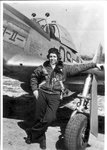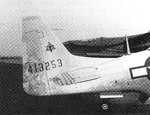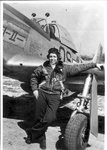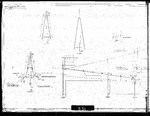drgondog
Major
IMO - you outlined all the external changes from D-10 that I was aware of except the fuel drain access door on rear cowling. For grins I'll hunt the drawing number to see the effectivities but it certainly would not have been limited to only Inglewood 51's.
Just looked - take a look at the Effectivity Block Notes - upper LH corner, zone 8, 109-25001 (S51 ref for image 000000130 in Folder "S")
USED ON P-51D-10-NT SUBS
USED ON P-51D-15-NA SUBS
ALSO ON LAST 600 OF BLOCK P-51D-10-NA
" " " 200 OF BLOCK P-51D-5-NT
Taking it to the Next Assembly Dwg 106-31001 (Ref R159 Effectivity Notes 2. 3 - Zone 1) for 25001-3 Fin
NAA 109 44-14253 Sub, NA 111 44-11153 Sub.----> same blocks as above - just specifying serial number instead of Contract ship #
That would place the 'Straight' DFF into production starting on #201 through #800 of P-51D-10= 44-14253
and would start the Dallas production with the P-51D-5-NT #1 starting at 44-11152.
The 200 D-5-NT preceded the K series, then 1500 K's were built plus 160 F-6K's (44-11353-44-12852) and then the rest of the Dallas line finished up the P-51D-20NT through 45-11742 plus one P-51M 45-11743.
Personally, I believe the Drawing Effectivities which means that the straight DFF seen on any P-51D/K during WWII started with P-51D-10-NA 44-14253 and P-51D-5-NT 44-11153. Stated another way Only the P-51D-5-NA through the 200th P-51D-10-NA had the curved DFF.
Having said this I have seen mid range P-51D-10-NA's that do not appear to have perfectly straight DFF making me pause and speculate that some got out of the barn after the Effectivity Block break.
Back to Creamer's ship. It Could very well be a -15-NA, but there is nothing definitive to state with certainty that it was a -15 absent the serial number as the P-51K-5 and Subsequent also had square aperture w/plastic cover..
I am also curious regarding when the 332nd first received D's. I have a hard time believing that they did not get early -10's or damaged/repaired -5's, but there was discrimination and not out of the question that somebody at 15th AF level Logistics delayed P-51Ds..
I'll take a look at Baugher's site as well as Aviationarcheology.com
Just looked - take a look at the Effectivity Block Notes - upper LH corner, zone 8, 109-25001 (S51 ref for image 000000130 in Folder "S")
USED ON P-51D-10-NT SUBS
USED ON P-51D-15-NA SUBS
ALSO ON LAST 600 OF BLOCK P-51D-10-NA
" " " 200 OF BLOCK P-51D-5-NT
Taking it to the Next Assembly Dwg 106-31001 (Ref R159 Effectivity Notes 2. 3 - Zone 1) for 25001-3 Fin
NAA 109 44-14253 Sub, NA 111 44-11153 Sub.----> same blocks as above - just specifying serial number instead of Contract ship #
That would place the 'Straight' DFF into production starting on #201 through #800 of P-51D-10= 44-14253
and would start the Dallas production with the P-51D-5-NT #1 starting at 44-11152.
The 200 D-5-NT preceded the K series, then 1500 K's were built plus 160 F-6K's (44-11353-44-12852) and then the rest of the Dallas line finished up the P-51D-20NT through 45-11742 plus one P-51M 45-11743.
Personally, I believe the Drawing Effectivities which means that the straight DFF seen on any P-51D/K during WWII started with P-51D-10-NA 44-14253 and P-51D-5-NT 44-11153. Stated another way Only the P-51D-5-NA through the 200th P-51D-10-NA had the curved DFF.
Having said this I have seen mid range P-51D-10-NA's that do not appear to have perfectly straight DFF making me pause and speculate that some got out of the barn after the Effectivity Block break.
Back to Creamer's ship. It Could very well be a -15-NA, but there is nothing definitive to state with certainty that it was a -15 absent the serial number as the P-51K-5 and Subsequent also had square aperture w/plastic cover..
I am also curious regarding when the 332nd first received D's. I have a hard time believing that they did not get early -10's or damaged/repaired -5's, but there was discrimination and not out of the question that somebody at 15th AF level Logistics delayed P-51Ds..
I'll take a look at Baugher's site as well as Aviationarcheology.com

![356fg pre lyons OSF 415189 [randall].jpg](/forum/data/attachments/277/277988-6d9ab19b33acce4e33210286e6cc5813.jpg)
![357 OSW_Becky_Wilson_st DFF_Jan1945 [claar].jpg](/forum/data/attachments/277/277989-b68e4029e09ebcbebcc66e8467d7ab9e.jpg)
![357 OSG_Big Stoop_Misner 414282 [shewfelt].jpg](/forum/data/attachments/277/277990-7a61e25e901ed505d05f240fa199339a.jpg)
![358 YFY Tulloch 414163 st DFF [drakecrow and Randall].JPG](/forum/data/attachments/277/277991-19588ca4bc83d3393f0e90fd3b4b2437.jpg)
![357 OSA_Jersey Bounce_Iglesias_415595 [iglesias].jpg](/forum/data/attachments/277/277992-5fa98269d3fa649aaa36c02c60ad3d3f.jpg)
![358 YFH_Susan B III (ex WRBbar JaneIV)_Kouche_414799 St DFF [marshall].jpg](/forum/data/attachments/277/277993-99ba2760591e69f4ceacad581628342b.jpg)


![357 OSB_Super Sal II D-5NT [delhammer].jpg](/forum/data/attachments/278/278089-7b4f75afe90ff0af58f8e0ee1a5ac0c4.jpg)

